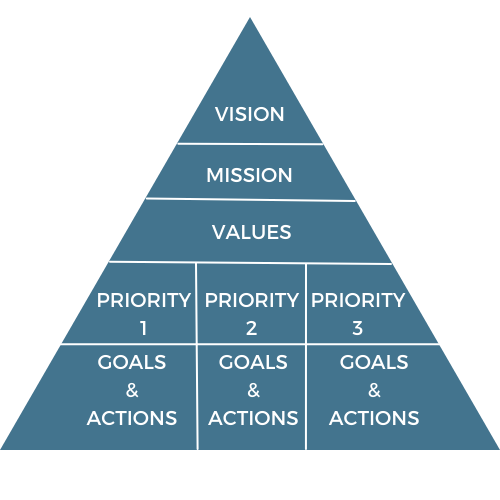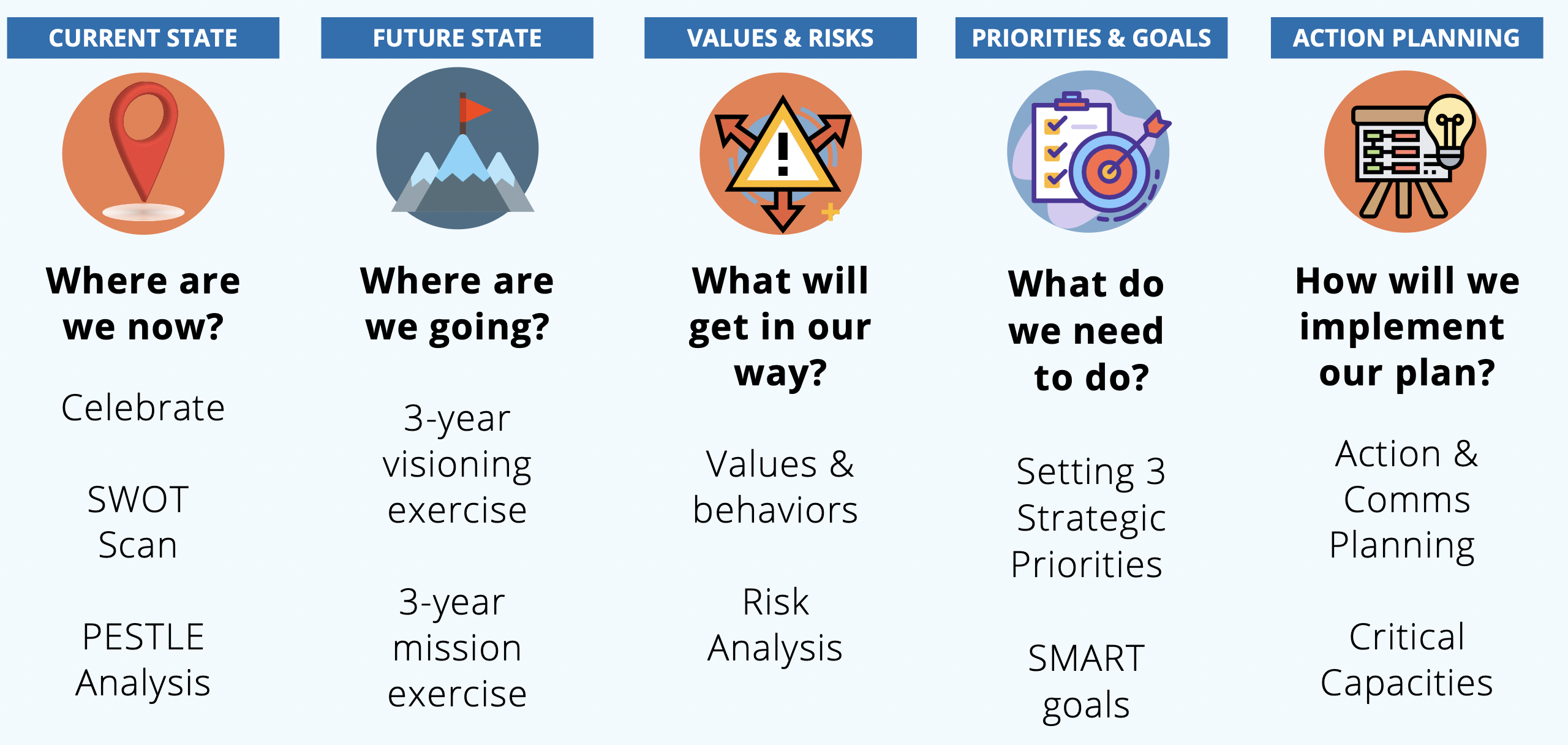
As an organization, determining your direction and achieving your goals requires a well-defined and effective strategic planning process. This process is essential to develop a culture of alignment and follow-through within your team. In this guide, we'll take you through each step of the strategic planning process to help you achieve success and determine:
- The direction of your organization (Vision)
- What you're going to do and for whom (Mission)
- How to measure it and guide your strategy to get to where you want to be (Goals)
Why is strategic planning important for your organization?
How do we define an effective strategic plan?
Breaking Down the Strategic Planning Process: 2-Day Agenda Mapping
The complete strategic planning process (Steps 1- 8)
Before we get into the steps, it's important to understand why we do strategic planning in the first place:
To get your team on the same page and aligned with your organization's vision, mission, and goals so that you're all escaping the dreaded multiple destination trap and working towards the same "One Destination".
To maximize your organization's resources to avoid wasting time and money on projects or activities that are not important
To understand industry trends and scenarios that could impact your organization in the coming years
To identify and evaluate the best way to accomplish your goals
To develop an implementation plan to keep you and your team aligned on track and accountable for deliverables
And much more ...
There are many different ways you can create a strategic plan, much like there are several different ways you can create a meal, and some may be more efficient than others.
We will share the process that we, at SME Strategy, believe best prepares leadership and management teams with sufficient information and direction to create and implement their strategic plan.
Download our free Strategic Planning Template and start your strategic planning process today
A strategic plan is a valuable guide for your employees, your organization's leadership and stakeholders to know where you're going and why you're going there.
The document that contains the strategic plan is not what is valuable; it's the information within it and the process used to create it, that is then SHARED and COMMUNICATED with the rest of your team. A great strategy is most often re-evaluated on an ongoing basis (yearly or quarterly, for example), rather than being a static document just sitting in a binder.
Strategy is about choices, which is knowing what to do as much as knowing what not to do. Your strategic plan tells your people what they should be doing so that they don't have to worry about doing the wrong things, or having to go to a manager every time there is a decision to make.
A strategic plan that is well communicated gives you access to greater productivity, culture, empowerment, and overall effectiveness.
Now that you know the importance of strategic planning, let's walk through the strategic planning process in four steps:
- Part one: How did we get to where we are now?
- Part two: Where do we want to go? What is our vision of success?
- Part three: What is going to get in our way? What do we need to be aware of?
- Part four: What do we need to do to get there?
In our two day sample strategic planning agenda, we break down the entire strategic planning process outlined above, or if you're a larger organization we recommend following a three day strategic planning agenda. There are also many different strategic planning tools and frameworks that you can incorporate in your planning process, and throughout the creation of your business strategy.
The headers outlined above are some of the key questions that you need to answer first, while the video and breakdown below will guide you through the intricate steps of the process.
The complete strategic planning process

Strategic Planning Step 1: Gather inputs
-
Successes and results from past strategic plans, environmental scans, and staff surveys - get our 15 Questions to Ask Your Team
-
PESTLE: Outside of your business, there are many factors that affect how you can do business, competitors being one, but also the Political, Economic, Social, Technological, Legal and Environmental climates that your organization or business operates in.
-
SWOT: Throughout the strategic planning process, you'll also have to identify internal processes and situations that may affect where you go in the future (strengths and weaknesses). There are also external factors that might affect your business strategy (opportunities and threats).
-
These "inputs" are the ingredients to your successful strategic plan. The right information will help you make the right decisions, so gather and assess carefully. Once you know where you are at as an organization, and what's going on in the world outside of your organization, then you can start to figure out where you're going.
Strategic Planning Step 2: Vision
- Where are you going? What does winning look like?
- There's one thing to have a vision statement, and it's another to have a very clear vision of the future, like a blueprint to a house. This is the foundation of your strategic plan.
- As an organization (for-profit, non-profit, government, growing startup, etc.), what are you building, and what is that rallying point for your people?
- Spending the time to get agreement and alignment on this future is key, because otherwise each individual will be following their own destination of success.
- Another way to think of your vision is: "If success was a place, how would we know if we got there"
Strategic Planning Step 3: Mission
- What is your purpose? Why do you exist? What do you do, and who do you do it for?
- This is an opportunity to focus your energy on a specific set of stakeholders (staff, shareholders, board, customers, etc). If you had to dedicate the majority of your resources to a group, who would it be? This is a tough question because the tendency is to say: "everyone".
- Your mission is the key driver in accomplishing your vision. It's your HOW.
Strategic Planning Step 4: Values
- If you want to find the number one contributor to a successful organization, it's having values that are understood and agreed on.
- Values create a set of behaviors that everyone on the organization can count on and expect.
- It's like having everyone playing by the same rules that clearly identify how you can be successful. You want your people to feel successful and fulfilled in their jobs? Live, eat and breathe your values so they know how they can contribute to making the organization a success.
- Watch: How to Influence Workplace Values
Strategic Planning Step 5: Competition, Risks and Road blocks
- You didn't think it was going to be that easy did you? There will always be things that will get in your way of success. If you take the time to identify scenarios, what the impact of specific roadblocks happening will be, and what you're going to do to mitigate these risks, you are less likely to be caught off guard.
- You can look at incorporating a risk register or scenario planning as frameworks to help you manage these risks and uncertainties.
Strategic Planning Step 6: Strategic Priorities, Goal, Strategies and Tactics
- This is where you can tie into the big picture thinking into action items as part of your strategic planning process.
- Strategic priorities are a handful of areas that will make the most amount of progress towards accomplishing your vision.
- Want to increase the focus of your strategic planning? Focus on the right strategic priorities.
- Once you have your strategic priorities, find a way to measure its success. Think of it as moving it from its current state: X, to its future state: Y by a certain date. From X to Y by DATE
- Then you make the individual action steps that are going to contribute to the accomplishment of that goal. Check out this article if you want some ideas on what strategic priorities to pick as part of your strategic plan.
Strategic Planning Step 7: Communication Plan
- This is where you'll make your plan as a team to communicate your strategic plan, and the things that you're going to get people bought in to your plan.
- Remember how we mentioned that a shelf plan is not very useful, and that making sure you keep your strategic plan and strategic priorities at the top of mind is key; this is where you do that.
- Audio, video, meetings, whatever you need to do: Let people know where the organization is going, and how they can contribute to making that plan a success.
- Communication goes both ways. You'll have better buy-in if you listen as well as speak. That's the difference between pushing a plan on people, versus pulling them towards you and inspiring them to want to contribute.
Strategic Planning Step 8: Action plan
- Implementation is where most organizations falter, so a strong action plan is needed.
- Now that you know where you're going, and how you're going to measure your success, do the things that are going to move the needle on the success of your strategic plan.
Big picture thinking is the easy part of the strategic planning process. What's a little harder is the implementation of the strategic plan in practice. Most organizations fail at implementing their strategic plans - 71% failure rate (See slide deck above for why).
The strategic planning process might seem pretty simple at first, but the intricacies of people and the moving parts of most businesses make planning a crucial but also challenging art form. Combining effective long range planning, with short term implementation is a skill of great managers and great leaders.
NEXT STEPS:
To ensure that your strategic planning process is effective, it's important to involve every member of the team who will be participating in the planning sessions. By doing so, you increase the likelihood of achieving alignment and buy-in from all participants.
If you're leading the strategic planning process, or having someone else facilitate the session(s), it's essential to think about who will be involved and get them included in the planning process from the outset.
Click to learn how a strategic planning facilitator can guide you through a proven strategic planning process to create alignment and a shared vision of success for your organization.
Learn how to create your own strategic plan from scratch with our video course


